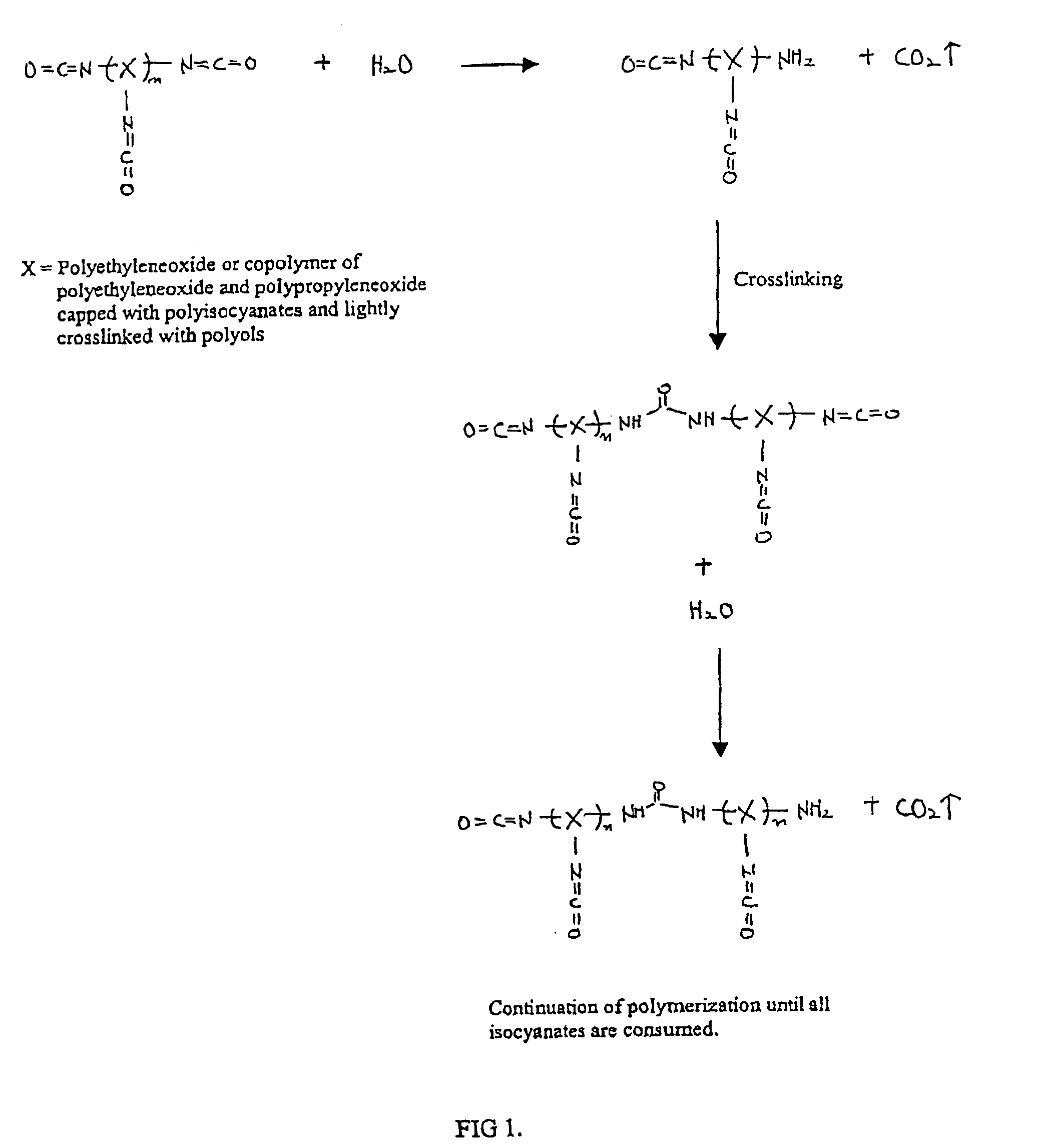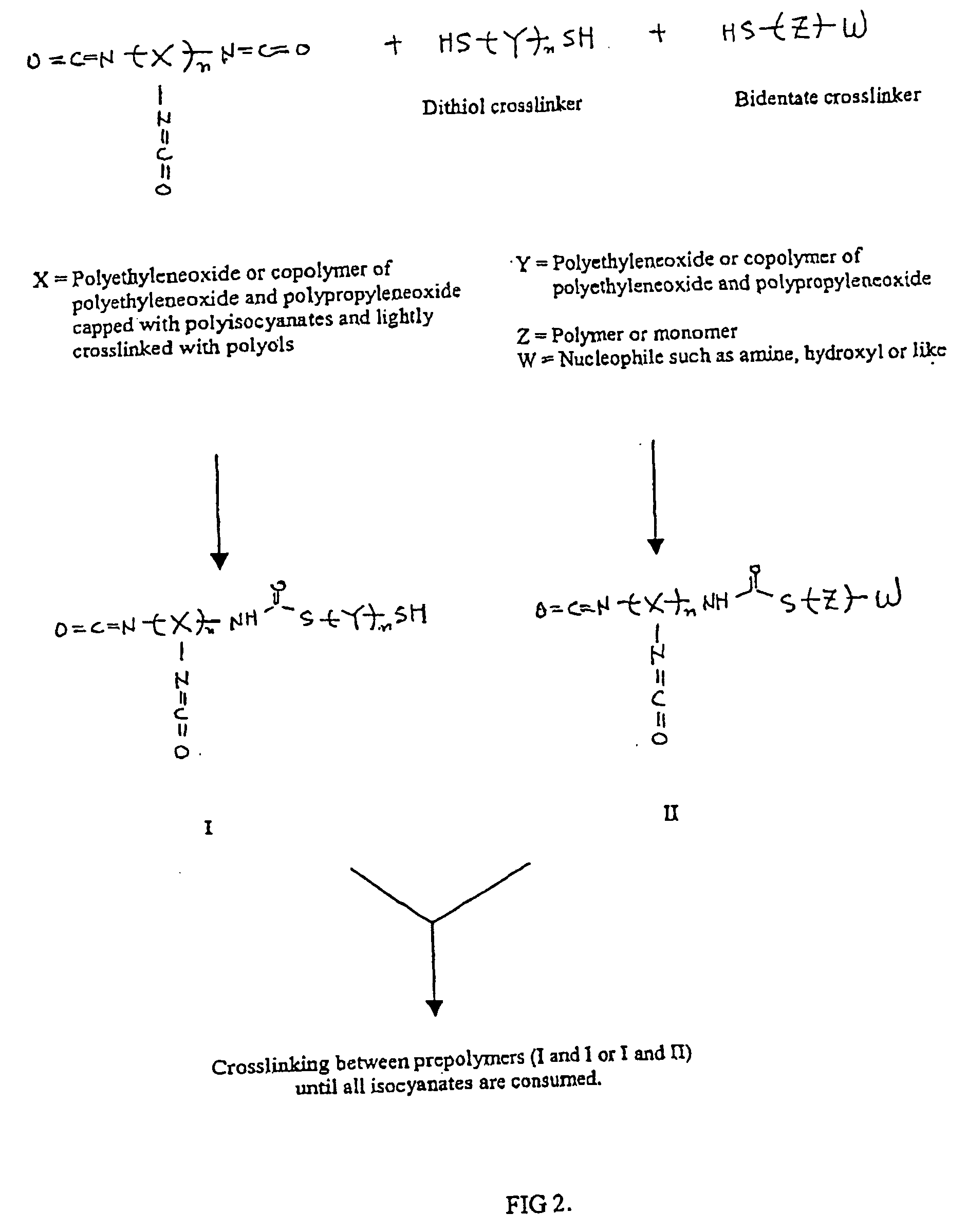Methods and gel compositions for encapsulating living cells and organic molecules
a technology of organic molecules and gel compositions, which is applied in the field of gel compositions for encapsulating living cells and organic molecules, can solve the problems of many materials suitable for gentle conditions, many of the materials suitable for these gentle conditions, and lack of structural requirements and/or biostability necessary for broad applications
- Summary
- Abstract
- Description
- Claims
- Application Information
AI Technical Summary
Benefits of technology
Problems solved by technology
Method used
Image
Examples
example 2
[0037] Solution A was prepared by mixing 0.1 g of Hypol PreMa G-50 (Hampshire Chemical Corp.) and 1 mL of 50 mM phosphate buffer, at pH 7.0 with 80 mM sodium chloride. Solution B was prepared by the same procedure as in Example 1. Solution C was prepared by mixing 40 .mu.L of Solution B with 70 .mu.L of goat lymphocytes in Dulbecco's phosphate-buffered saline. Finally, 100 .mu.L of Solution A was mixed with 100 .mu.L of Solution C, and the resulting solution was microspotted using the same procedure as in Example 1. The formulation polymerized in 5 minutes, and the hydrogel spots were treated with Dulbecco's modified phosphate-buffered saline solution and incubated at 37.degree. C. for 1 day to 3 days in RPM1640 cell media. The viability of lymphocytes was examined with a light microscope using AlamarBlue which demonstrated viable encapsulated cells.
example 3
[0038] Solution A was prepared by mixing 0.1 g of Hypol PreMa G-50 (Hampshire Chemical Corp.) and 1 mL of 50 mM phosphate buffer, at pH 7.0 with 80 mM sodium chloride. Solution B was prepared by the same procedure as in Example 1. Solution C was prepared by mixing 40 .mu.L of Solution B with 70 .mu.L of E. coli in Dulbecco's phosphate-buffered saline. Finally, 100 .mu.L of Solution A was mixed with 100 .mu.L of Solution C, and the resulting solution was placed into a disposable culture tube. The formulation polymerized in 5 minutes, and the hydrogel was treated with Dulbecco's modified phosphate-buffered saline solution and incubated at 37.degree. C. for 1 day in RPM1640 cell media. Viability and growth of E. coli were confirmed by observing turbidity in the hydrogel after 1 day.
example 4
[0039] Solution A was prepared by mixing 0.1 g of Hypol PreMa G-50 (Hampshire Chemical Corp.) and 1 mL of 50 mM phosphate buffer, at pH 7.0 with 80 mM sodium chloride. Solution B was prepared by dissolving 30 mg of PEG-(thiol).sub.2 (mw=3,400) and 2 mg of free base cysteine in 1 mL of 50 mM phosphate buffer, at pH 7.0 with 60 mM sodium chloride. 25 .mu.L of Solution A, 10 .mu.L of Solution B, 5 .mu.L of 50% trehalose in DI water and 10 .mu.L of anti-transferrin antibody (goat anti-human transferrin, 5 mg / ml, protein-G purified)(Calbiochem) were mixed, and the resulting solution was microspotted onto an amine-treated glass slide so as to form spots 300 .mu.m to 1,000 .mu.m in diameter and at least 20 .mu.m in height. Other similar spots were created without the addition of the anti-transferrin antibody. The hydrogel spots were carefully polymerized in a humidity box at room temperature and 95% RH, and after polymerization, the hydrogel spots were found to be physically stable and wel...
PUM
| Property | Measurement | Unit |
|---|---|---|
| Length | aaaaa | aaaaa |
| Solubility (mass) | aaaaa | aaaaa |
| Molecular weight | aaaaa | aaaaa |
Abstract
Description
Claims
Application Information
 Login to View More
Login to View More - R&D
- Intellectual Property
- Life Sciences
- Materials
- Tech Scout
- Unparalleled Data Quality
- Higher Quality Content
- 60% Fewer Hallucinations
Browse by: Latest US Patents, China's latest patents, Technical Efficacy Thesaurus, Application Domain, Technology Topic, Popular Technical Reports.
© 2025 PatSnap. All rights reserved.Legal|Privacy policy|Modern Slavery Act Transparency Statement|Sitemap|About US| Contact US: help@patsnap.com


